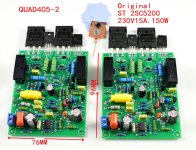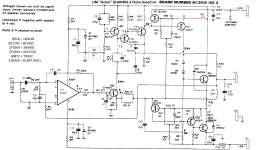There is no point to any of this. The current sensing resistors, which BTW are 0.091 ohms, not 0.5, are correctly rated already, as are the 560 ohm resistors. I've repaired many dozens of 405s and never seen either fail. The CRC filter (presumably in the PSU) is also pointless. The SNR of a 405 is already -100dB: how much quieter do you really need it to be? What you are claiming about capacitors frequency-shifting noise and only resistors reducing noise is rubbish.
Member
Joined 2009
Paid Member
I misspoke. 405-II -96dB 'A' weighting, -93dB; unweighted 15.7kHz measurement bandwidth, both ref. full power..
Thanks! On the DeSmith site it says gain is 330k / 22k = 15. Dropping 330k down to 100k = 4.5
There is a 47nf cap between the two resistors but no mention is made what to do with this, should this be left alone.
Yes I do! Please see https://nick.desmith.net/Electronics/QUAD_upgrades.html#gain . Note there I explain the rationale and recommend that C4 should go to 150nF
BTW, the surname is "de Smith" 😎
Changing the gain doesn't change the output power. It just changes the input level required to get that power.
The gain change is simply to get full output (almost) at standard line levels rather than Quad's preamp output levels. i.e. to allow the 405-2 to use a non-Quad preamp.
I am referring to the wording on your site. It says explicitly that you lose power. You don't.
I know what a gain change is for.
I know what a gain change is for.
I'm very pleased for you.
If you read further in that paragraph you'll see that the output power for 1.5VRMS input is 85W and that the full 100W is achievable only with 1.63VRMS in. i.e there's no reduction in the output power capability of the amplifier (obviously).
So under normal circumstances with a 1.5VRMS input, the total power available will be below the 100W maximum possible.
If you read further in that paragraph you'll see that the output power for 1.5VRMS input is 85W and that the full 100W is achievable only with 1.63VRMS in. i.e there's no reduction in the output power capability of the amplifier (obviously).
So under normal circumstances with a 1.5VRMS input, the total power available will be below the 100W maximum possible.
I quote from your web page: "Note that by reducing the front-end gain to 4.6 rather than 5 reduces the power output (into 8 ohms) from 100WRMS to a theoretical 85WRMS."
This claim is not correct.
You could always just fix it.
This claim is not correct.
You could always just fix it.
We're going to have to agree to disagree. Context matters: If you quoted the whole paragraph rather than just selectively just choosing the first sentence, you would see that:
In the the 12 years that this page has been active, out of the many 1,000s of page views and probably 100s of emails to me from people who've successfully used this information, there's only been one person that has had a problem with the wording.
Note that by reducing the front-end gain to 4.6 rather than 5 reduces the power output (into 8 ohms) from 100WRMS to a theoretical 85WRMS. It might seem a bigger drop than you would expect, but remember that power depends on the square of the voltage gain - to get a full 100WRMS you will actually need 1.63VRMS of input.
In the the 12 years that this page has been active, out of the many 1,000s of page views and probably 100s of emails to me from people who've successfully used this information, there's only been one person that has had a problem with the wording.
Last edited:
Good morning,
I just installed 2 Quad 405-2 clones boards in my #405 housing (one of the original board being defective, that was cheaper than reparing it) so powered under +/- 50 VDC. I have only changed the 560 ohm resitors by 5 W ones, and replaced the TL031 by OPA627. Result is excellent, <60 mV offset, no oscillation, it sounds better than the original #405 (which was >40 years old with chemical capacitors changed 10 years ago).
Then, I have a question: how would perform BurrBrown 2132P or AD826AN compared to OPA627 ?
Thanks for specialists'expertise !!!!
I just installed 2 Quad 405-2 clones boards in my #405 housing (one of the original board being defective, that was cheaper than reparing it) so powered under +/- 50 VDC. I have only changed the 560 ohm resitors by 5 W ones, and replaced the TL031 by OPA627. Result is excellent, <60 mV offset, no oscillation, it sounds better than the original #405 (which was >40 years old with chemical capacitors changed 10 years ago).
Then, I have a question: how would perform BurrBrown 2132P or AD826AN compared to OPA627 ?
Thanks for specialists'expertise !!!!
Offset should be well under 10mV. There is something wrong. You don’t need 5W resistors in a 1.4W application. And the opamp is irrelevant beyond a certain point, which you’ve already crossed with the OPA627.
The original speaker protector is a very poor design! It directly short-circuits the positive terminal of the output to ground.很多這些克隆似乎沒有揚聲器保護?
opa627 are very good so you will hear a different kind of sound rather than any improvements, the 627 is a little dark sounding. If you want improvemnts switch to burson or some other discrete op amp, there are a lot of posts out there about this so read up and decide what you want to do. You will need to reduce the 3.3kohm resistors before the opampGood morning,
I just installed 2 Quad 405-2 clones boards in my #405 housing (one of the original board being defective, that was cheaper than reparing it) so powered under +/- 50 VDC. I have only changed the 560 ohm resitors by 5 W ones, and replaced the TL031 by OPA627. Result is excellent, <60 mV offset, no oscillation, it sounds better than the original #405 (which was >40 years old with chemical capacitors changed 10 years ago).
Then, I have a question: how would perform BurrBrown 2132P or AD826AN compared to OPA627 ?
Thanks for specialists'expertise !!!!
The distortion produced by the main amplifier in a 405 is two orders of magnitude greater than that of any modern opamp. That’s 40dB.
Not all Quad 405 clone boards are same. I bought one sometime ago but it came with different mounting holes and wouldn't fit into my original 405 chassis.Good morning,
I just installed 2 Quad 405-2 clones boards in my #405 housing (one of the original board being defective, that was cheaper than reparing it) so powered under +/- 50 VDC. I have only changed the 560 ohm resitors by 5 W ones, and replaced the TL031 by OPA627. Result is excellent, <60 mV offset, no oscillation, it sounds better than the original #405 (which was >40 years old with chemical capacitors changed 10 years ago).
Then, I have a question: how would perform BurrBrown 2132P or AD826AN compared to OPA627 ?
Thanks for specialists'expertise !!!!
BTW, I watched some testing of Quad 405 clone on YouTube. They perform badly with 20KHz square wave. Can anyone verify 20KHz square wave?
I have 6 PCB left over from builds for myself and a relative, they are direct copies of a PCB commisioned by a company based in Antwerp, Belgium. I have most of the components to populate the boards apart from the opamps, I used OPA627 in the original builds but they are no longer available in DIP package. I am loathe to use SOIC>DIP adaptors but if needs be I will. The absurdly expensive OPA627BM I would not consider on cost. I used OPA604 originally but after trying an OPA627 in one channel and 604 in the other I prefer the 627, subjective experience only of course.
Buying obsolete components outside of accredited suppliers will not happen, I see Burr Brown and Analog Devices IC's on Ali for wildly diffreing prices and know full well none are likely to be genuine, I look just for the lols.
Thoughts on this issue welcome.
Buying obsolete components outside of accredited suppliers will not happen, I see Burr Brown and Analog Devices IC's on Ali for wildly diffreing prices and know full well none are likely to be genuine, I look just for the lols.
Thoughts on this issue welcome.
They are not intended to perform well on a 20kHz square wave. The HF pole is at 40kHz, so not muchoif the squareness will survive. The important thing at that frequency is the sine wave, unless you think you can hear above 40kHz, and your speakers will reproduce it, and your sources and preamps.They perform badly with 20KHz square wave.
Very few power amps will perform well supersonically.
Sometimes measurements can be misleading or open to interpretation. For the money you pay, the quad boards are excellent value, give good sound quality, are reliable with a long life, and can be modded up. You are getting a good deal. If you don't like the sound try something different, there's a ton of boards out there and a ton of free advice as well.Not all Quad 405 clone boards are same. I bought one sometime ago but it came with different mounting holes and wouldn't fit into my original 405 chassis.
BTW, I watched some testing of Quad 405 clone on YouTube. They perform badly with 20KHz square wave. Can anyone verify 20KHz square wave?
- Home
- Amplifiers
- Solid State
- QUAD 405 clone

